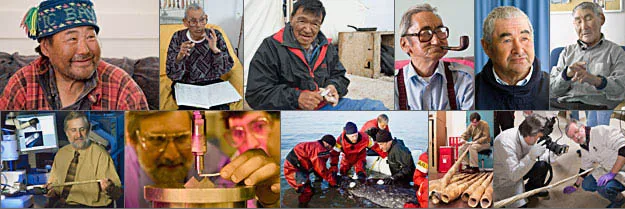Baffin Bay Region Narwhal Research
Interviews with hunters
Harvard researcher Martin Nweeia interviewed 55 elders and hunters from Inuit communities in Canada and Greenland. Each interviewee contributed knowledge that helped Nweeia and his fellow researchers understand the purpose of the narwhal's tusk. Interviews are conducted in several dialects of both Inuktitut and Greenlandic, but are conducted with the aid of an English translator.
Cornelius Nutarak Interview
Location: Pond Inlet, Canada
Date: 4 June 2010
Keywords: Narwhal behavior, narwhal migration, tusk differences, beluga whales, differences between male and female narwhals, qirnajuktat, uses of tusk, tusk length, tusk size, double tusks, niksiulangata avataaniinginnaqtuq, qaulluvisat, arnanngaliit, hunting.
Elisapee Ootova
Location: Pond Inlet,Canada
Date: 4 June 2010
Keywords: Narwhal behavior, narwhal migration, tusk differences, differences between male and female narwhals, uses of tusk, tusk length, tusk size, double tusks, tiggak, arnarluk, ugiuqu, hunting.
Ikey Kigutikakjuk
Location: Arctic Bay, Canada
Date: 4 June 2010
Keywords: Narwhal behavior, narwhal migration, tusk differences, differences between male and female narwhals, qirnajuktat, uses of tusk, tusk length, tusk size, double tusks, hunting.
Jayko Peterloosie
Location: Pond Inlet, Canada
Date: 4 June 2010
Keywords: Narwhal behavior, narwhal migration, tusk differences, beluga whales, differences between male and female narwhals, qirnajuktat, uses of tusk, tusk length, tusk size, double tusks, niksiulangata avataaniinginnaqtuq, qaulluvisat, arnanngaliit, hunting.
Jaypeetee Qarpik
Pangnirtung, Canada
4 June 2010
Narwhal behavior, narwhal migration, tusk differences, differences between male and female narwhals, qirnajuktat, uses of tusk, tusk length, tusk size, double tusks, hunting.
Joanasie M
Location: Pangnirtung, Canada
Date: 4 June 2010
Keywords: Narwhal behavior, narwhal migration, tusk differences, differences between male and female narwhals, qirnajuktat, uses of tusk, tusk length, tusk size, double tusks, hunting.
Lisha Levi
Location: Arctic Bay, Canada
Date: 4 June 2010
Keywords: Narwhal behavior, narwhal migration, tusk differences, differences between male and female narwhals, qirnajuktat, uses of tusk, tusk length, tusk size, double tusks, hunting.
Mucktar Akumalik
Location: Arctic Bay, Canada
Date: 4 June 2010
Keywords: Narwhal behavior, narwhal migration, tusk differences, differences between male and female narwhals, qirnajuktat, uses of tusk, tusk length, tusk size, double tusks, hunting.
Peteroosie Qappik
Pangnirtung, Canada
4 June 2010
Narwhal behavior, narwhal migration, tusk differences, differences between male and female narwhals, qirnajuktat, uses of tusk, tusk length, tusk size, double tusks, hunting.
Ragelee Arnaquq
Location: Broughton Island, Canada
Date: 4 June 2010
Keywords: Narwhal behavior, narwhal migration, tusk differences, differences between male and female narwhals, qirnajuktat, uses of tusk, tusk length, tusk size, double tusks, hunting.
Seetee Nattiapik
Location: Broughton Island, Canada
Date: 4 June 2010
Keywords: Narwhal behavior, narwhal migration, tusk differences, differences between male and female narwhals, qirnajuktat, uses of tusk, tusk length, tusk size, double tusks, hunting.

